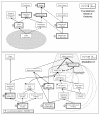Comparing the representation of anatomy in the FMA and SNOMED CT
- PMID: 17238300
- PMCID: PMC1839313
Comparing the representation of anatomy in the FMA and SNOMED CT
Abstract
Objective: This paper reports on the alignment between two large ontologies of anatomy: the Foundational Model of Anatomy (FMA) and the representation of anatomical structures in SNOMED CT. The objective of this study is to investigate the compatibility between a reference ontology of anatomy (the FMA, 75,019 concepts) and a representation of anatomy created for use in clinical applications (SNOMED CT, 30,933 anatomical concepts).
Methods: The alignment first identifies shared concepts lexically. The presence of shared relations across ontologies is then used to validate the mappings structurally.
Results: 8,228 mappings were identified by lexical methods, of which over 97% were supported by structural evidence. No evidence was found for 0.5% of the mappings and 2.5% received negative evidence.
Conclusions: Despite important differences in coverage and knowledge representation between the FMA and SNOMED CT, we have not noticed any major discrepancies in their representation of anatomical entities.
Figures
Similar articles
-
The use of semantic distance metrics to support ontology audit.AMIA Annu Symp Proc. 2010 Nov 13;2010:842-6. AMIA Annu Symp Proc. 2010. PMID: 21347097 Free PMC article.
-
Alignment of multiple ontologies of anatomy: deriving indirect mappings from direct mappings to a reference.AMIA Annu Symp Proc. 2005;2005:864-8. AMIA Annu Symp Proc. 2005. PMID: 16779163 Free PMC article.
-
Desiderata for domain reference ontologies in biomedicine.J Biomed Inform. 2006 Jun;39(3):307-13. doi: 10.1016/j.jbi.2005.09.002. Epub 2005 Oct 17. J Biomed Inform. 2006. PMID: 16266830
-
Use of the Systematized Nomenclature of Medicine Clinical Terms (SNOMED CT) for Processing Free Text in Health Care: Systematic Scoping Review.J Med Internet Res. 2021 Jan 26;23(1):e24594. doi: 10.2196/24594. J Med Internet Res. 2021. PMID: 33496673 Free PMC article.
-
The practical impact of ontologies on biomedical informatics.Yearb Med Inform. 2006:124-35. Yearb Med Inform. 2006. PMID: 17051306 Review.
Cited by
-
Experience in Aligning Anatomical Ontologies.Int J Semant Web Inf Syst. 2007;3(2):1-26. doi: 10.4018/jswis.2007040101. Int J Semant Web Inf Syst. 2007. PMID: 18974854 Free PMC article.
-
Prediction and curation of missing biomedical identifier mappings with Biomappings.Bioinformatics. 2023 Apr 3;39(4):btad130. doi: 10.1093/bioinformatics/btad130. Bioinformatics. 2023. PMID: 36916735 Free PMC article.
-
Variation in the representation of human anatomy within digital resources: Implications for data integration.AMIA Annu Symp Proc. 2018 Dec 5;2018:330-339. eCollection 2018. AMIA Annu Symp Proc. 2018. PMID: 30815072 Free PMC article.
-
Leveraging biomedical ontologies and annotation services to organize microbiome data from Mammalian hosts.AMIA Annu Symp Proc. 2010 Nov 13;2010:717-21. AMIA Annu Symp Proc. 2010. PMID: 21347072 Free PMC article.
-
NEO: Systematic Non-Lattice Embedding of Ontologies for Comparing the Subsumption Relationship in SNOMED CT and in FMA Using MapReduce.AMIA Jt Summits Transl Sci Proc. 2015 Mar 25;2015:216-20. eCollection 2015. AMIA Jt Summits Transl Sci Proc. 2015. PMID: 26306275 Free PMC article.
References
-
- Staab S, Studer R, editors. Tools for mapping and merging ontologies. Handbook on Ontologies: Springer-Verlag; 2004. pp. 365–384.
-
- Rosse C, Mejino JL., Jr A reference ontology for biomedical informatics: the Foundational Model of Anatomy. J Biomed Inform. 2003;36(6):478–500. - PubMed
Publication types
MeSH terms
Grants and funding
LinkOut - more resources
Full Text Sources
Other Literature Sources
Medical

